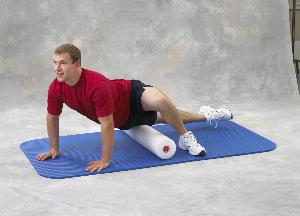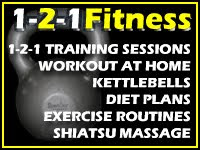
A decade ago, strength coaches and athletic trainers would have looked quizzically at a 36-inch long cylindrical piece of foam and wondered, "What is that for?" Today, nearly every athletic training room and most strength and conditioning facilities contain an array of foam rollers of different lengths and consistencies.
What happened to bring foam rollers into prominence? The change has been in our attitude toward massage therapy. We have been slowly moving away from an injury care mode of isokinetics and electronics to more European-inspired processes that focus on hands-on soft tissue care. We now realize that techniques like massage, Muscle Activation (MAT), and Active Release Therapy (ART) can work wonders for sore or injured athlete.
In addition, the understanding at the elite athlete level is: If you want to stay healthy, get a good manual therapist in your corner. Thus, athletes at all levels are starting to ask for some form of soft tissue care.
What does all this have to do with foam rollers? As coaches and athletic trainers watched elite-level athletes experience success from various soft tissue techniques, the obvious question arose: How can I make massage available to large groups of athletes at a reasonable cost? Enter the foam roller.
National Academy of Sports Medicine President Michael Clark, DPT, MS, PT, NASM-PES, is credited by many-this author included-with exposing the sports medicine community to the foam roller. In one of Clarke's early manuals, he included a few photos of self-myofascial release using a foam roller. The technique illustrated was simple and self-explanatory: Get a foam roller and use your bodyweight to apply pressure to sore spots.
Since then, many of us have discovered more uses for foam rollers, including injury prevention and performance enhancement. We've also moved away from the accupressure concept and now use them more for self-massage. And we've come up with specific protocols for different situations.
Essentially, foam rollers are the poor man's massage therapist. They provide soft tissue work to the masses in any setting. But you need to know their nuances to get the most out of them.
What, How & When
A foam roller is simply a cylindrical piece of extruded hard-celled foam. Think swimming pool noodles, but a little more dense and larger in diameter. They usually come in one-foot or three-foot lengths. I find the three-foot model works better, but it obviously takes up more space.
They are also now available in a number of densities from relatively soft foam (slightly harder than a pool noodle), to newer high-density rollers that feel much more solid. The denser the athlete, the more dense the roller should be. Large, heavily-muscled athletes will do better with a very high density roller whereas a smaller, younger athlete should begin with a less dense product.
The application techniques are simple. Clarke's initial recommendation was based on an accupressure concept, in which pressure is placed on specific surfaces of the body. Athletes were instructed to use the roller to apply pressure to sensitive areas in their muscles-sometimes called trigger points, knots, or areas of increased muscle density. The idea was to allow athletes to apply pressure to injury-prone areas themselves.
The use of foam rollers has progressed in many circles from an accupressure approach to self-massage, which I've found to be more effective. The roller is now usually used to apply longer more sweeping strokes to the long muscle groups like the calves, adductors, and quadriceps, and small directed force to areas like the TFL, hip rotators, and glute medius.
Athletes are instructed to use the roller to search for tender areas or trigger points and to roll these areas to decrease density and over-activity of the muscle. With a little direction on where to look, most athletes easily find the tender spots on their own. However, they may need some instruction on the positioning of the roller, such as parallel, perpendicular, or 45 degrees, depending on the muscle.
The feel of the roller and intensity of the self-massage should be properly geared to the age, comfort, and fitness level of the athlete. This is one of the plusses of having the athlete roll themselves-they can control the intensity with their own body weight.
There is no universal agreement on when to roll, how often to roll, or how long to roll, but generally, techniques are used both before and after a workout. Foam rolling prior to a workout can help decrease muscle density and promote a better warmup. Rolling after a workout may help muscles recover from strenuous exercise.
My preference is to have athletes use the rollers before every workout. We also use them after a workout if athletes are sore.
One of the nice things about using the foam roller is that it can be done on a daily basis. In fact, in their book, The Trigger Point Therapy Workbook, Clair Davies and Amber Davies recommend trigger point work up to 12 times a day in situations of acute pain.
How long an athlete rolls is also determined on a case-by-case basis. I usually allow five to 10 minutes for soft tissue activation work at the beginning of the session prior to warmup. If my athletes roll after their workout, it is done for the same length of time.
Some Specifics
While the foam roller can be used on almost any area of the body, I have found it works best on the lower extremities. There is not as much dense tissue in the upper body and our athletes are not prone to the same frequency of upper body strains as lower. The hamstrings and hip flexors seem to experience the most muscle strains, so we concentrate on those areas.
Here are some protocols I use:
Gluteus max and hip rotators: The athlete sits on the roller with a slight tilt and moves from the iliac crest to the hip joint to address the glute max. To address the hip rotators, the affected leg is crossed to place the hip rotator group in an elongated position. As a general rule of thumb, 10 slow rolls are done in each position (although there are no hard and fast rules for reps). Often athletes are simply encouraged to roll until the pain disappears.
TFL and Gluteus Medius: The tensor fasciae latae and gluteus medius, though small in size, are significant factors in anterior knee pain. To address the TFL, the athlete begins with the body prone and the edge of the roller placed over the TFL, just below the iliac crest
After working the TFL, the athlete turns 90 degrees to a side position (see Figure Three on page XX) and rolls from the hip joint to the iliac crest to address the gluteus medius.
Adductors: The adductors are probably the most neglected area of the lower body. A great deal of time and energy is focused on the quadriceps and hamstring groups and very little attention is paid to the adductors. There are two methods to roll the adductors. The first is a floor-based technique that works well for beginners. The user abducts the leg over the roller and places the roller at about a 60-degree angle to the leg. The rolling action begins just above the knee in the area of the vastus medialis and pes anserine, and should be done in three portions. To start, 10 short rolls are done covering about one third the length of the femur. Next, the roller is moved to the mid-point of the adductor group and again rolled 10 times in the middle third of the muscle. Last, the roller is positioned high into the groin almost to the pubic symphysis for a final set of 10 rolls.
The second technique for the adductors should be used after the athlete is comfortable with the first one. This exercise requires the athlete to sit on a training room table or the top of a plyometric box, which allows him or her to shift significantly more weight onto the roller and work deeper into the large adductor triangle. The athlete then performs the same rolling movements mentioned above.
Although I primarily use the rollers for athletes' legs, they can also be used with upper extremities. The same techniques can be used for pecs, lats, and rotator cuffs, although with a much smaller amplitude-making the movements closer to accupressure.
Assessing Effectiveness
Foam rolling is hard work that can even border on being painful. Good massage work, and correspondingly good self-massage work, may be uncomfortable, much like stretching. Therefore, it is important that athletes learn to distinguish between a moderate level of discomfort related to working a trigger point and a discomfort that can lead to injury.
When an athlete has completed foam rolling, he or she should feel better, not worse. And the rollers should never cause bruising. Ask the athlete how his or her muscles feel after each session to assess if the techniques are working.
I also judge whether foam rolling is working by monitoring compliance. If I don't have to tell athletes to get out the foam roller before a workout, I know the techniques are working. Most do it without prompting as they see the benefits.
Rolling vs. Massage
The question often arises: "Which is better, massage therapy or a foam roller?" To me the answer is obvious: Hands-on work is better than foam. Hands are directly connected to the brain and can feel. A foam roller cannot feel. If cost was not an issue I would have a team of massage therapists on call for my athletes at all times.
However, having an abundance of massage therapists on staff is not in most of our budgets. Therein lies the beauty of the foam rollers: They provide unlimited self-massage for around £20. Sounds like a solution to me.





No comments:
Post a Comment